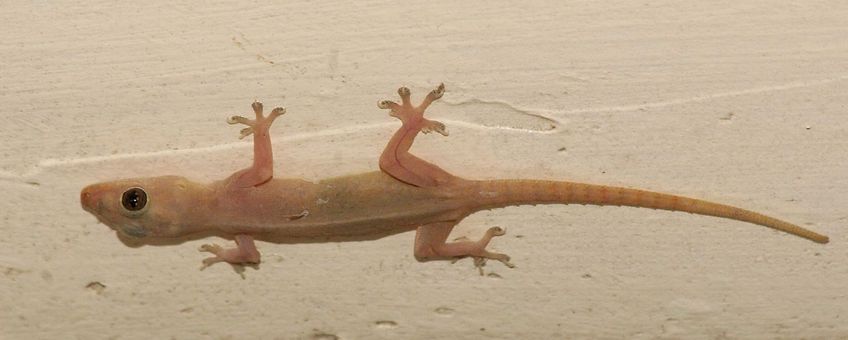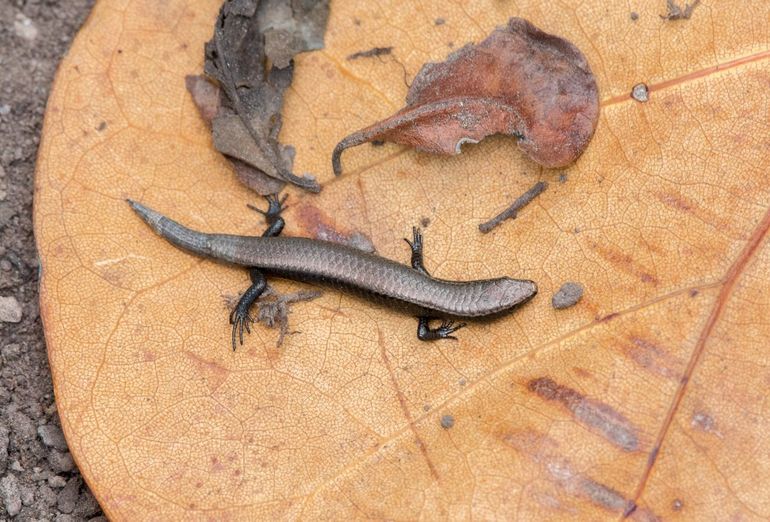
Invasion of non-native reptile species continues in the Lesser Antilles
Wageningen UniversityUnderwood’s spectacled tegu (Gymnophthalmus underwoodi) originates from South America and the most southern islands of the Lesser Antilles. However, in the last couple of years multiple populations have established themselves in more northerly located areas, like Saint Martin and Florida, and most recently (2021) on Saba. The current increase of non-native reptile populations is linked to transport of goods by sea. On Sint Eustatius, underwood’s spectacled tegu has been observed since 2020 across the whole island. A special characteristic of the animal is that all individuals are female, and no males are necessary for successful reproduction (parthenogenesis). Partly due to this strategy of reproduction, underwood’s spectacled tegu can multiply rapidly once it enters new areas or arrives on a new island.
Some people might know the common house gecko (Hemidactylus frenatus) as a regular pet of reptile hobbyists, however, this animal also has a large natural area of distribution and is very common in the wild. The original distribution of this gecko species is in South-East Asia, but it currently occurs in Australia, North and South America and Saint Martin. The species has now been documented for Sint Eustatius where it is found along with another Hemidactylus species, namely the tropical house gecko (Hemidactylus mabouia). This gecko, which has been present on Sint Eustatius for a longer time, also is non-native for the island. Prior research has shown that the common house gecko is much more competitive than the tropical house gecko and is known to outcompete the latter over time. Therefore, it can be expected that the tropical house gecko will eventually disappear from Sint Eustatius. After mating, a female can carry viable sperm for up to 36 weeks, which boosts its fecundity and helps the species establish itself rapidly in new areas.

Increase in non-native animal species in the region
In recent years, the number of populations of non-native reptile species on Sint Eustatius and Saba have increased remarkably. For example, both the underwood’s spectacled tegu and the brahminy blind snake (Indotyphlops braminus) were recently found on Saba. This non-native blind snake had already been found on Sint Eustatius. In addition, green iguanas (Iguana iguana) also occasionally make their way over as stowaways on cargo ships.
It is striking that most newly-introduced species in the region are first reported on Saint Martin, and a few years later on the surrounding islands, like Saba and Sint Eustatius, both of which are principally supplied with materials and merchandise from the ports of Saint Martin and Florida. These ports thus have an important negative role in the spread of non-native animals in the region and it is urgent that more attention is paid to methods and protocols regarding biosecurity.
Little is known about the influence of either species on the ecology of Sint Eustatius. However, it is a given fact that the introduction of non-native animals is one of the largest causes of worldwide biodiversity decline. Introduced plants and animals can not only often outcompete the native organisms, but may cause genetic pollution or introduce new diseases and pests to native populations.
Iguanas
Both Sint Eustatius and Saba are home to unique and critically endangered iguana populations. In addition to the loss of (quality of) habitat, the introduction of the non-native green iguana has now become the greatest threat to the future of the native iguana populations. The presence of a large non-native iguana population on Saint Martin, which is serving as an important source of non-native animals hitchhiking to Saba and Sint Eustatius is particularly worrisome. When these green iguanas manage to reproduce on Saba and Sint Eustatius, unless measures are taken this can easily mean the end of the unique iguanas due to a combination of genetic mixing and competition. In order to protect the unique flora and fauna of Sint Eustatius, Saba, and other surrounding islands, it is therefore critically important that biosecurity in the ports within the Dutch Caribbean becomes more strict.
More information
- The establishment of both species on Sint Eustatius is described in an article (pdf; 6.0 MB) in the scientific journal Caribbean Herpetology.
Text: Matthijs van den Burg, Julian Thibaudier and Dolfi Debrot, Wageningen Marine Research
Photos: Gerard van Buurt (lead photo: common house gecko (Hemidactylus frenatus)); Matthijs van den Burg
